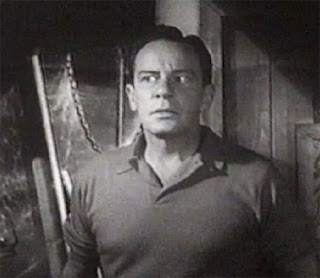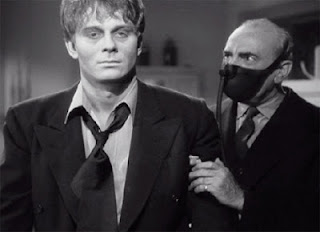Now Playing: Tormented (1960)
Pros: A very quirky, offbeat story for the time period and genre; Stolid B movie leading man Richard Carlson plays against type; A surprisingly good child actress
Cons: Uneven and misused special effects serve to dissipate the spooky atmosphere and tension
Pros: A very quirky, offbeat story for the time period and genre; Stolid B movie leading man Richard Carlson plays against type; A surprisingly good child actress
Cons: Uneven and misused special effects serve to dissipate the spooky atmosphere and tension
A little while back a friend and I were speculating on what new social media application(s) young people will turn to now that their parents and grandparents have invaded Facebook and ruined it for them. Facebook investors take note: I've been on it for a year or so now, and the surest sign of the decline and fall of a service like this is when old people like me start grudgingly using it.
The mass exodus of the young from Facebook is just another, though potent, indicator of the widening generation gap. (No doubt my use of an old term like "generation gap" only serves to further that gap-- my apologies to anyone under 30 who might have somehow stumbled upon this post!) Obviously, tensions between the young and the old are part of being human, but from my grumpy old man perspective, the divisions have gotten a lot worse.
Those of you who've lived more than a couple of decades may be thinking, how could the generation gap be any wider than it was in the late '60s and early '70s, with hippies and yippies howling at their scowling elders, burning draft cards and bras, turning on to drugs, tuning in, and dropping out? In contrast to the Vietnam-era generation, today's youth are generally reserved, rule governed, conformist, and materialistic. In 21st century America, what's not to like about that?
Just this: rebellion is still a form, albeit a crude one, of engaging with your perceived adversary. With engagement, there's hope for resolution or at least an uneasy truce. Some rebellion is a good, healthy thing-- testing boundaries is an essential part of the maturing process. But it seems to me that young people today don't rebel in healthy ways. They simply ignore anything and everything that is not an immediate part of their social circle. Nothing interesting happened or was created before they were born. Nothing interesting or creative will happen after they're gone. It's as if we've unleashed an entire generation of mutant Anthony Fremonts who have banished anything that's not all about them -- their age, their interests, their culture -- to the "cornfields" of their minds (The Twilight Zone's "It's a Good Life").
 |
| Tom Stewart (Richard Carlson) is bewitched, bothered and tormented. |
It wasn't always so. For every Invasion of the Saucer Men or Giant Gila Monster featuring teen protagonist-heroes, there were at least 2 or 3 sci-fi/fantasy flicks of the '50s and '60s that featured honest-to-goodness adult protagonists, some well into middle age and beyond. Kids flocked to drive-ins and hometown theaters to see these films, and apparently had no problem with significant adult characters.
One very significant adult "character" from 1950s sci-fi was stolid B movie leading man Richard Carlson. He was already in his 40s when he made his first B sci-fi movie, The Magnetic Monster, in 1953 (see the post on this and other Fantastic Faceless Foes of '50s Sci-fi elsewhere on this blog). The classics for which he's known today, It Came From Outer Space and Creature From the Black Lagoon, followed quickly after that (1953 and 1954 respectively). He even found time during that period to direct a sci-fi movie (Riders to the Stars, 1954) and a western (Four Guns to the Border, 1954). Later in the '50s he turned almost exclusively to television, writing and directing as well as acting.
Like his B movie cohorts John Agar and Robert Hutton, Carlson projected a straight-arrow, Dudley Do-Right image in most of his films. He was that square-jawed, intelligent, levelheaded guy you wanted on your side when the chips were down. Almost always. In Tormented, he's a regular, very flawed human being who pays dearly for his indiscretions.
 |
| Vi Mason (Juli Reding) confronts her old flame at the abandoned lighthouse. Watch that handrail! |
Well, not quite-- Tom's problems have only just begun. Like the self-obsessed cad he is, Tom tries to tell himself that Vi's death wasn't his fault. But Vi's very active ghost begs to differ. When she told Tom "I'll never leave you, I'll always be with you," she really meant it. Just like a Master Card from Hell, her vengeful spirit starts turning up everywhere Tom wants to be. Walking on the beach, Tom spies her body floating in the surf, picks her up, and carries her onto the beach. As he looks on in horror, the body suddenly morphs into a stinking human-sized pile of seaweed. Later, as Tom and his fiance stroll leisurely along the beach, footprints from an invisible being follow closely behind.
 |
| Vi seems to have lost her head over the suave jazz pianist Tom Stewart. |
But Tom's problems aren't all other-worldly. A very corporeal threat in the form of a tugboat captain (Joe Turkel) turns up just before the wedding. Seems he'd been promised money by a beautiful blonde to ferry her over to the island for a visit with a well-known jazz musician. But she hadn't kept her appointment to go back to the mainland, and the boatman knows she didn't take the regular ferry. He puts two and two together, and decides he can make a lot more than just the price of a boat ride off the harried Tom. Big mistake. Tom decides to deal with the blackmailer in the same unsafe lighthouse that took Vi's life, but he just digs a deeper hole for himself. His fiance's little 9 year-old sister Sandy (Susan Gordon) adores Tom, but is concerned about him as he starts losing it from the stress of the hauntings and the blackmail. She follows him to the lighthouse, and sees something she shouldn't… Now Tom's really up the proverbial creek without a paddle. What to do… what to do?!
 |
| Susan Gordon as little Sandy is surprisingly good. |
Bert I. Gordon (or Mr. B.I.G.) also gets points for originality. Bert was known for his fixation with all things gigantic (e.g., The Amazing Colossal Man, 1957), so a ghost story was quite a departure for him. In addition to writing, directing and producing, Bert also supervised the special effects for his films. Unfortunately, his penchant for effects serves to subvert the tense, spooky atmosphere of Tormented. Ghosts in the movies are the opposite of children -- they're best heard, not seen (for an absolutely masterful example of how to scare with just sound and suggestion, see Robert Wise's The Haunting, 1963). Vi's ghost is bold, brassy and in-your-face… but not very scary. Bert seems to mistake quantity for quality. He throws every ghostly cliché at the screen -- footprints from an invisible being, disembodied hands and heads, flowers wilting in the ghost's presence, etc., etc. By the time poor Tom holds up Vi's disembodied head as it yells "Tom Stewart killed me!" over and over, we've given up being scared and at best, are mildly curious about what effects stunt Mr. B.I.G. will pull next. (See more about Mr. B.I.G. in my post on The Cyclops.)
Still, what's Halloween without ghosts, however cheesy they may be? Tormented would be a fun, kitschy addition to a ghostly movie marathon with say, The Haunting and The Woman in Black to provide authentic scares. Tormented is available in its entirely on YouTube and the Internet Archive, as well as on DVD from Alpha Video.
"You belong to me Tom... you belong to a ghost!"











